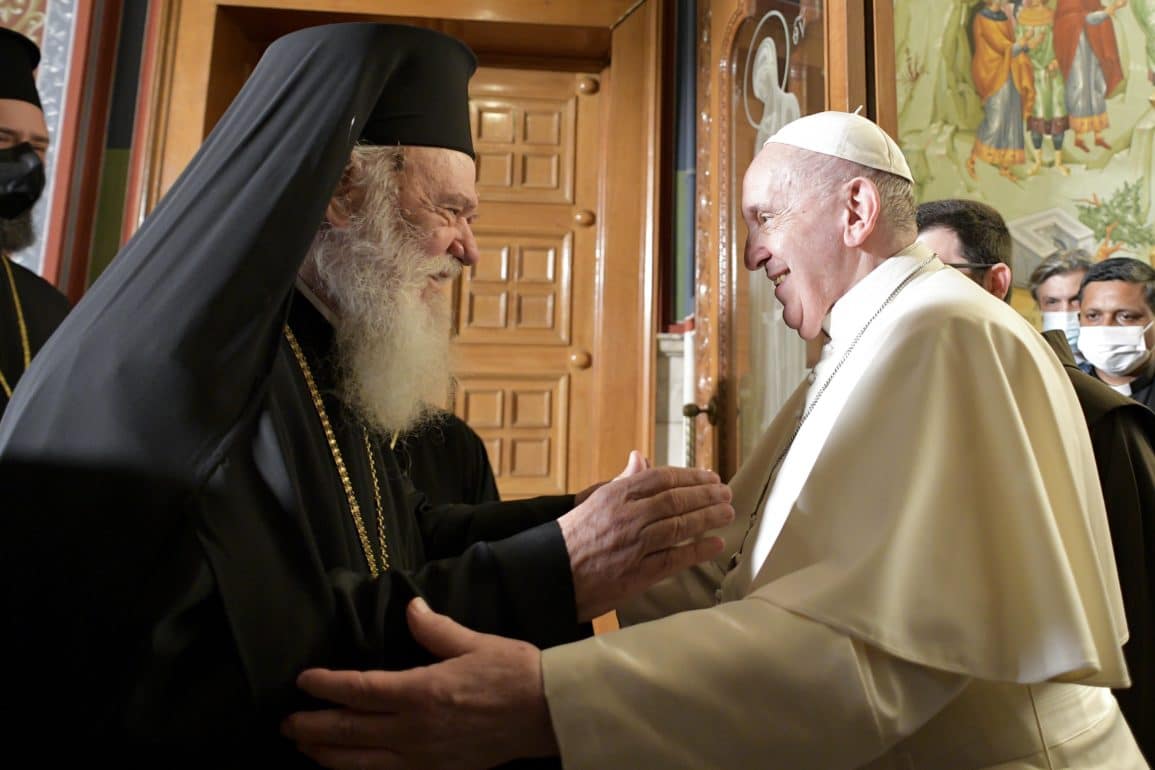At around 4 p.m. (3 p.m. in Rome), Pope Francis went to the Orthodox Archbishop’s Palace in Athens to pay a courtesy visit to Hieronymos II, archbishop of Athens and all of Greece. This is an overwhelmingly Orthodox country, with a small Catholic community made up mainly of foreign immigrants.
On April 16, 2016, Hieronymos II visited the Mòrias camp on the island of Lesbos, together with Pope Francis and the ecumenical patriarch Bartholomew, to raise awareness of the refugee problem. The three Christian leaders signed a joint statement. In addition to his pastoral ministry, he continued his research on Christian archeology by publishing books and numerous articles and studies on theological, social, and historical topics.
This new meeting between the Pope and the archbishop, within the framework of the 35th apostolic trip to Cyprus and Greece of the Bishop of Rome, will be followed by an official meeting with their respective entourages, in the Throne Room of the Orthodox Archbishop of Athens. Upon his arrival at the archbishopric, the Pontiff was received at the main entrance of the Orthodox Archbishop’s Palace by the protosicelo (vicar) and two clergymen. At the interior entrance, Jerónimo II, along with three of his close collaborators, receives Francisco. Together, they have gone to a room to have a dialogue for a few minutes.
Hieronymos II
Born Ioannis Liapis, archbishop of Athens and of all Greece and primate of the Autocephalous Orthodox Church of Greece, he was born in Oinofyta, Boeotia, in 1938 into an ethnic Albanian (Arvanite) family. He graduated from the Faculty of Philosophy and the Faculty of Theology at the University of Athens and graduated from Archeology, Byzantine Studies, and Theology. He continued his university studies at the universities of Graz, Austria, Regensburg, and Munich, Germany.
He worked as an assistant professor at the Archaeological Society of Athens with the famous archaeologist Anastasios Orlandos and later taught literature at the Leonin Lyceum in Athens and in other schools in the capital and Asopia. He was ordained a deacon and then a priest in 1967, abandoning his academic career. He was protosicelo (vicar) of the diocese of Thebes and Levadeia, aegumen (abbot) of the monasteries of the Transfiguration of Sagmata and Hosios Loukas (1971-1981), secretary and later main secretary of the Holy Synod of the Church of Greece (1978- 1981).
In 1981 he was elected Metropolitan Bishop of Thebes and Levadeia, and on February 7, 2008, Archbishop of Athens and all Greece, taking office on February 16, 2008. During his ministry as Metropolitan Bishop of Thebes and Levadeia, renewed and added new religious personnel to 6 monasteries and 17 convents.
His initiatives in the social sphere were also numerous. He founded boarding schools, introduced the institution of foster families, opened orphanages, homes for the elderly, mental health centers, a training center for the creative employment of children with special needs, a center for the prevention of drug addiction, soup kitchens for the poor, including immigrants, counseling centers and a center for historical and archaeological studies, maintaining strong relationships with the teaching community of Viotia. He also helped create a Center to sensitize the citizens of his hometown, Oinofyta, about the problems of immigrants.
Orthodox Archbishopric of Greece
It is located in a building located about 200 meters from the Metropolitan Cathedral of the Annunciation of Mary, also known as the Great Mitropolis. The latter was built in the Plaka neighborhood to serve as the cathedral of the metropolitan of Athens instead of the Panagia Gorgoepíkoös church, located next door.
The works began in 1843 and lasted about twenty years due to the difficulty of finding funds. Finally, in 1862 the building was completed under the direction of the French architect François Boulanger, who designed the dome and the two bell towers and was consecrated. Built in the Byzantine-modern style with three naves, the church contains two important sarcophagi: that of the patriarch Gregory V, assassinated under Ottoman rule in 1821, and, opposite, the silver sarcophagus of Saint Philothea, martyr of the Greek Orthodox Church and Patron of the city of Athens, dating from 1589. Since 1999, when it suffered a strong earthquake, the place of worship is held inside with iron supports.
The Metropolitan Orthodox Diocese of Athens was elevated to the rank of Archdiocese on December 31, 1923, and its Archbishop was named Archbishop of Athens and all of Greece.










